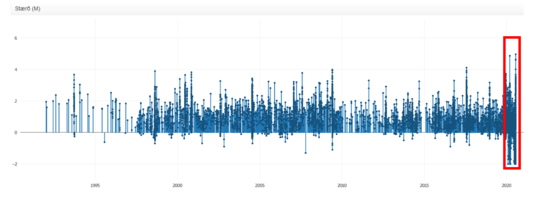An earthquake swarm in Fagradalsfjall
On 19th July at approximately 01:30 a.m. a seismic swarm commenced in Fagradalsfjall. Over 1700 earthquakes have occurred in this region since. The largest event occurred at 23:36 yesterday evening with a magnitude (M) of 5. Two other events greater than M4 occurred early this morning at 05:46 (M4.6) and 06:23 (M4.3), respectively. In addition, 22 earthquakes greater than M3 have occurred since midnight. Felt earthquakes have been reported by local residents as far Akranes in the west and Vík in the east. The seismic swarm is still ongoing with similar intensity.
Earhquake activity within the Fagradalsfjall area is not uncommon, and seismic swarms have occurred in the past – five significant swarms have occurred here since 1991. However, a swarm of this intensity (both in terms of number of events and magnitude of earthquakes) is not common. The last period of comparable activity was on the 16th September 1973, during which time five earthquakes greater than M4 and one greater than M5 were recorded.

The seismic activity in the vicinity of Fagradalsfjall since 1991, the current activity is the in the red box.
Difficult to interpret the evolution but a few scenarios are possible
The current seismic activity appears to coincide with a series of North-Souh trending tectonic faults. This would indicate these events are of a tectonic nature, but most likely they are the result of stress triggering related to the ongoing magmatic unrest on the Reykjanes Peninsula, which commenced in January this year. Since multiple magmatic instrusions have now occurred beneath the Peninsula since this time, we cannot rule out that the current seismic swarm is the result of an intrusion beneath Fagradalsfjall.
If earthquake activity is related to a magmatic intrusion, then the same hazards would apply as stated previously for Svartsengi/Grindavík, e.g. possibilty of a fissure eruption comprising lava fountaining, lava flows, gas emissions etc.
Possible scenarios:
1) Seismic
swarm wanes in the coming days/weeks. Potential for rockslides in the region.
2) Intensity of swarm increases with the occurrence of larger magnitude earthquake – up to M6.0.
3) Magma instrusion occurs in the vicinity Fagradalsjall:
i) Leads to an effusive eruption
ii) Intrusive activity declines and magma body solidifies
The current volcanic unrest in
the Reykjanes peninsula keeps changing with time and it is difficult to
anticipate its evolution in the future. The origin of this swarm will be verified after the acquisition
of new ground deformation data later this week.




